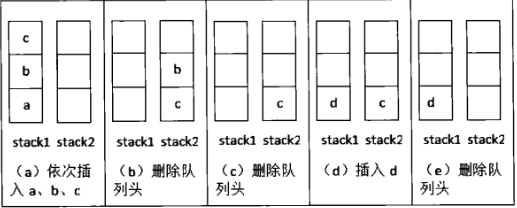面试中常出现让你手写两个队列实现一个栈,两个栈实现一个队列的问题,很是头疼!今天就仔细将我分析,思考过的Java代码给大家分享一下:(一)两个队列实现一个栈:

两个队列添加元素,哪个队列为空,由于在输出元素时,要进行相应元素的移动(除去尾部元素),所以要在对应不为空的队列进行元素的添加;在输出数据时,要进行两个队列的变相操作,不为空的队列要依次向为空的队列中添加元素,直到尾元素输出即可!
/**
* 两个队列实现一个栈
* @auther yangchao
* @date 2019/7/18
*/
public class TwoQueueImplStack {
private Queue<Integer> queue1 = new ArrayDeque<>();
private Queue<Integer> queue2 = new ArrayDeque<>();
/**
* 向栈中压入数据
* @param element
*/
public void push(Integer element) {
//两个队列为空时,优先考虑queue1
if (queue1.isEmpty() && queue2.isEmpty()) {
queue1.add(element);
return;
}
//如果queue1为空,queue2有数据,直接放入queue2
if (queue1.isEmpty()) {
queue2.add(element);
return;
}
//如果queue1为空,queue2有数据,直接放入queue2
if (queue2.isEmpty()) {
queue1.add(element);
return;
}
}
/**
* 取出栈中的数据
* @return
*/
public Integer poll() {
//两个队列为空时,直接抛出异常
if (queue1.isEmpty() && queue2.isEmpty()) {
throw new RuntimeException("stack is empty");
}
//如果queue1为空,将queue2中的元素依次加入到 queue1, 弹出最后一个元素
if (queue1.isEmpty()) {
while(queue2.size() > 1) {
queue1.add(queue2.poll());
}
return queue2.poll();
}
//如果queue2为空,将queue1中的元素依次加入到 queue2, 弹出最后一个元素
if (queue2.isEmpty()) {
while(queue1.size() > 1) {
queue2.add(queue1.poll());
}
return queue1.poll();
}
return null;
}
public static void main(String[] args) {
TwoQueueImplStack qs = new TwoQueueImplStack();
qs.push(2);
qs.push(4);
qs.push(7);
qs.push(5);
System.out.println(qs.poll());
System.out.println(qs.poll());
qs.push(1);
System.out.println(qs.poll());
}
}
输出结果:

(二)两个栈实现一个队列:
第一个栈只负责添加元素,第二个栈在弹出元素时,首先判断当前栈是否为空,若为空就直接将其第一个栈中的数据全部压入第二个栈中,然后输出栈顶元素,即可实现队列效果;若第二个栈中有数据,添加直接将其数据压入第一个栈中,输出时直接输出第二个栈顶的元素即可!
/**
* 两个栈实现一个队列
* @auther yangchao
* @date 2019/7/18
*/
public class TwoStackImplQueue {
private Stack<Integer> stack1 = new Stack<>();
private Stack<Integer> stack2 = new Stack<>();
/**
* stack1只负责压入队列元素
* @param element
*/
public void push(Integer element) {
stack1.add(element);
}
/**
* 取出队列顶部元素
* @return
*/
public Integer poll() {
//若stack2为空,将 stack1 中的元素压入 stack2
if (stack2.isEmpty()) {
while (stack1.size() > 0) {
stack2.add(stack1.pop());
}
}
if (stack2.isEmpty()) {
throw new RuntimeException("queue is Empty!");
}
Integer head = stack2.pop();
return head;
}
public static void main(String[] args) {
TwoStackImplQueue sq = new TwoStackImplQueue();
sq.push(1);
sq.push(3);
sq.push(5);
sq.push(4);
sq.push(2);
System.out.println(sq.poll());
System.out.println(sq.poll());
sq.push(7);
System.out.println(sq.poll());
}
}
输出结果:

每天进步一点点,继续加油......
